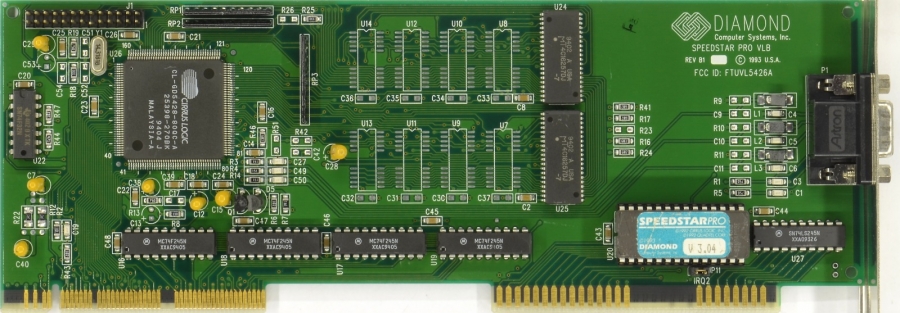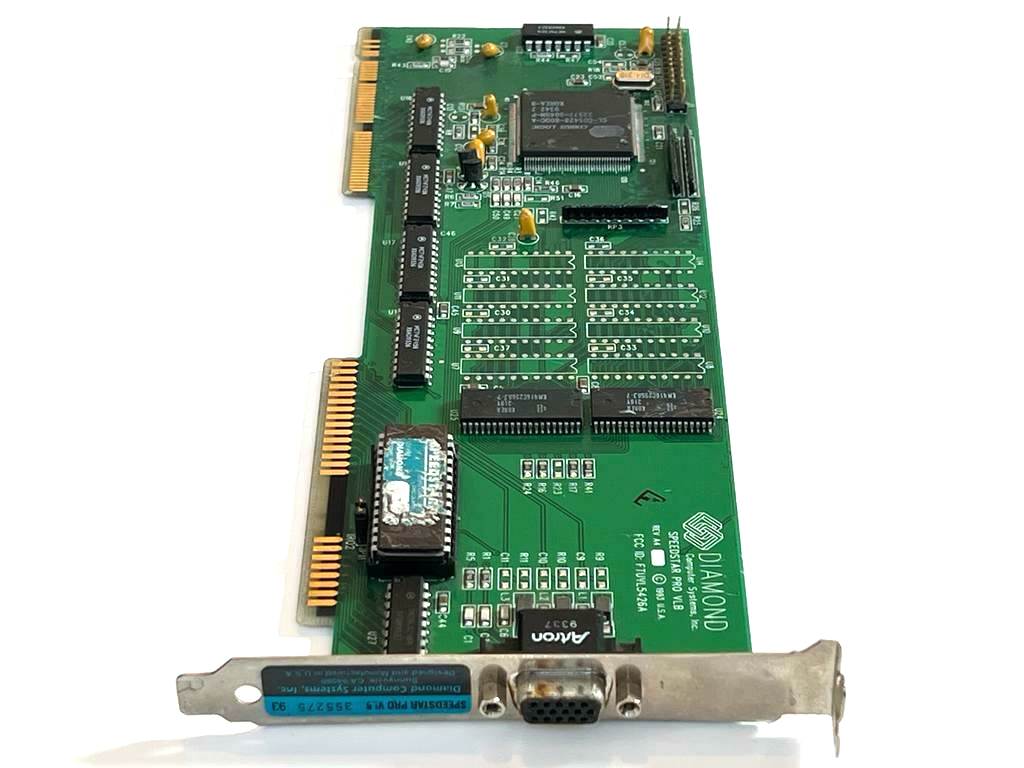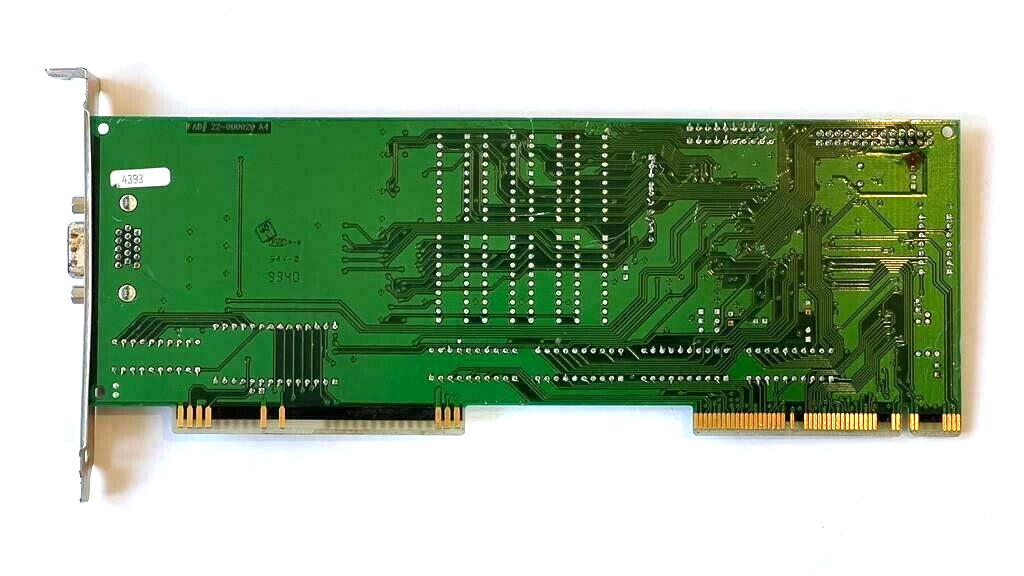Cirrus Logic CL-GD5428
The CL-GD5428 was a Super VGA chipset released in 1993. It was an enhanced version of the CL-GD5426 with a faster BitBLT engine.
|
Released | March 1993 |
| Bus | ISA 16-bit or VESA Local Bus | |
| Chipset | Cirrus Logic CL-GD5426 | |
| Standards | MDA, Hercules, CGA, EGA, VGA | |
| Memory | 1 MB or 2 MB FPM DRAM (70, 80 or 100ns) | |
| RAMDAC | (Internal) | |
| Part # | - | |
| See Also | CL-GD5426 |
The core clock on the 5428 still ran at the same speed as the 5422/5424/5425 and 5426 running at 80 MHz with memory clocking in at 50 MHz. In fact, the only diffentiator that it had over the 5426 was a faster BitBLT engine.
The faster performance of the 5428 came from its memory architecture, whereby card makers could still use the cheaper DRAM memory over dual-ported VRAM, but the chipset catered for buffered writes to memory at the same time as screen and memory refreshes. This was fine for lighter graphics loads, but struggled to match the performance of chipsets that fully supported VRAM like the S3 86C928, ATI Mach32, and Weitek P9000.
Like the CL-GD5426, the 5428 chipset was extremely popular, and can be found on the following SVGA cards:
- SPEA / Video7 Vega
- Diamond SpeedSTAR Pro VLB (FCC ID: FTUVL5426A)
- Octek VL-VGA-28 (EP20094R11)
- Pine Technology PT-524/8G (FCC ID: J6Q4LVLDM7)
- EliteGroup / ECS VI-710/711 (FCC ID: H9NVI710)
- STB Systems Horizon VGA
- VGA GUI 2100 (FCC ID JPM2100VIDE)
- UTD-01B Cl542X VESA Local Bus (FCC ID: J6Q4LVLDM7)
- Palm VL-Bus (FCC ID KGBPALMVL)
- ST242X-VL4 (FCC ID J6N4LVLDM7)
- Gainward (FCC ID: ICU VGA-GW 143B)
- GP-3200
- AGATech Corp (Taiwan) PWA-MVA-542X (FCC ID: JCC MVGA-524X)
- Cirrus Logic P202 (FCC ID J6N4LVLDM7)
- DFI WG-1000VL/4
- Hightech Information System (HK) - FCC ID KBIA3U5428
- Ambition Technology Co Ltd (Taiwan) - FCC ID: I7EAB-5426VL
- Protac International Corp (Taiwan) - FCC ID: J4UVGA826WVLC3
- Chain Plus Information Inc (Taiwan) - FCC ID: LII5428BVL
- Boca Research (USA) - FCC ID: EUD 5U9 BRI461Q
- Quantum Designs (HK) Ltd - FCC ID: KDECIRRUS5426VL
- Palit Microsystems Inc (Taiwan) - FCC ID: KC8PM-V116
Here is a summary of the Cirrus Logic CL-GD542x range so you can compare each chipset's differences from one another:
| 5420 | 5421 | 5422 | 5424 | 5425 | 5426 | 5428 | 5429 | |
|---|---|---|---|---|---|---|---|---|
| Bus | ISA | ISA | ISA | VLB | VLB | VLB | VLB | VLB |
| GUI Acceleration | - | - | - | - | - | BitBLT | Enhanced BitBLT | MM I/O |
| Max. Video Memory | 1 MB | 1 MB | 1 MB | 1 MB | 1 MB | 2 MB | 2 MB | 2 MB |
| Memory Bus Width | 16-bit | 16-bit | 32-bit | 32-bit | 32-bit | 32-bit | 32-bit | 32-bit |
| Host Interface Width | 16-bit | 16-bit | 16-bit | 16-bit | 16-bit | 16-bit | 16-bit | 16-bit |
| Core Clock Frequency | 75 MHz | 75 MHz | 80 MHz | 80 MHz | 80 MHz | 80 MHz | 80 MHz | 86 MHz |
| Memory Clock Frequency | 50 MHz | 50 MHz | 50 MHz | 50 MHz | 60 MHz | 50 MHz | 50 MHz | 60 MHz |
| Max. Resolution at 256 Colours | 1024 x 768 (NI) | 1024 x 768 (NI) | 1024 x 768 (NI) | 1024 x 768 (NI) | 1024 x 768 (NI) | 1280 x 1024 | 1280 x 1024 | 1280 x 1024 |
Revisions
The chipset itself came in these revisions: A.
Competition
The CL-GD5428 chipset competed at the higher end of the same chipsets that competed with the CL-GD5426 - namely, the S3 86C801 (cards including the Orchid Fahrenheit VA, Mirage Storm 1280/256, VideoSeven Win.PRO and Actix GraphicsEngine 32 Plus) and ATi Mach32 (cards including the ATI Graphics Ultra Plus and ATI Graphics Ultra Pro).
PC Magazine's 2 MB Video Boards round-up at the end of 1993 determined that cards based on the CL-GD5428 were near the top of the benchmark table in some tests where light acceleration was needed, but were outshone by others like the ATI Mach32 and S3 86C928 in more demanding applications.
The ISA version of the CL-GD5428 tended to perform on par with the Trident TVGA8900CL-C variant.
In the Media
If you're looking for a low-cost graphics accelerator that provides fast DOS and Microsoft Windows performance for general-purpose applications, boards based on the Cirrus Logic CL-GD5428 chip may be the answer. For image processing and other graphically intensive applications, you should consider boards that are better suited for a heavier workload.
The Actix ProStar VL is a steal at $169 (list), providing good Windows application performance and the same basic features (such as installation software and utilities) offered by all of the reviewed boards based on the Cirrus Logic CL-GD5428. The Cardinal VideoSpectrum VL, which lists for $199, had slightly weaker performance than the other boards in this category. The higher-priced Genoa WindowsVGA 24 Turbo ($289 list) provided higher refresh rates and came with better installation software and utilities than the other Cirrus Logic cards. The Boca Research VL-Bus SuperX VGA, which was the most expensive card in this category ($445 list), offered no discernible performance or features benefits to justify its higher price.
All of the Cirrus Logic boards we tested are local-bus cards that support a maximum of 64,000 colors in Super VGA. None of them, however, support 24-bit true-color graphics.
The boards using the CL-GD5428 all performed above average on our Winstone test. In 800-by-600 mode with 256 colors, they scored near the top with an average Winstone score of 52 with 16MB of RAM. The ProStar had the highest Winstone scores among the GD5428-based video processors, and was among the top-ten overall on this test.
In contrast, these same boards all scored below average on our WinBench test. This difference can best be explained by examining the differences between the two tests. WinBench issues many more Windows API calls per second than does Winstone. WinBench's Graphic WinMark exercises the API using a wide range of graphics calls with a large distribution of parameters. WinBench also utilizes dithering, which tests a board's color range more intensively.
We believe the difference between the Cirrus Logic cards' WinBench and Winstone results is due to the boards' design. The GD5428-based video cards in this roundup all use DRAM rather than VRAM. VRAM is dual-ported, which lets two operations occur simultaneously; the screen is updated while new video information is being accessed by the system. VRAM is also more expensive than DRAM, which is not dual-ported.
Designers of DRAM-based boards have to make up for the lack of dual-ported memory, which is critical to the effectiveness of the video boards' WinBench performance. The GD5428-based boards use an asynchronous architecture; buffering writes to memory while the screen and memory refresh are accessing the DRAM. Also, the GD5428 processor (like most of the adapters in this review) handles only two instructions per clock cycle.
This system seems to function well under the less intensive load of Winstone. WinBench, on the other hand, overloads the card with work, showing the limitations of the board's capabilities. Reliance on DRAM is what makes the GD5428-based cards fine performers for general applications but less effective for higher graphics loads.
While all these boards offer at least a 72-Hz refresh rate in 800-by-600 and 1,024-by-768 with 256 colors, the WindowsVGA 24 Turbo's refresh rates were exceptional: 90 Hz in 800-by-600 with 256 colors and 75 Hz in 1,024-by-768 with 256 colors. Also exceptional was the 87-Hz refresh rates posted by all the GD5428-based boards in 1,280-by-1,024 with 256 colors." PC Magazine, December 1993
Setting it Up
There is no known setup configuration for cards that have a CL-GD5428 chipset.
Downloads
Operation Manual Get in touch if you can provide this missing item! |
CL-GD5428 Drivers & Utilities Includes both DOS utilities (CLMODE) and drivers for specific applications, Windows 3.x display drivers for 16- and 256-colour modes.. |
CL-GD5426/5428 Windows 3.1 Drivers For all cards with CL-GD5426 or CL-GD5428 |
CL-GD542x Databook Provides technical information on the entire range of CL-GD542x graphics chipsets. |
Quadtel CL-GD5428 BIOS The 32 KB VGA ROM BIOS dump from a MachSpeed VGA GUI 2100 VLB card. |
More Pictures






